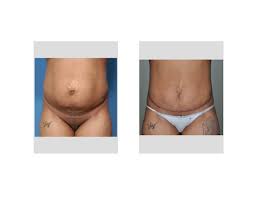
But there are many misconceptions about tummy tucks, some of which affects the timing of how the surgery is done and others about the recovery after the procedure.
A new belly button is made during a tummy tuck. The belly button is nothing more than a remnant or stalk of scar tissue from the skin down to the abdominal wall. It is never removed during a tummy tuck but rather the skin around it is. The stalk of the belly button is always preserved, it is the loose skin around it and any extra length that is removed. The stalk of the belly button is simply put back by bringing it through the abdominal skin that has been tightened over it. Reshaping of the belly button is almost always done as part of remaking it. The key to a good looking belly button result in a tummy tuck is to shorten it so that the skin dips in, the surrounding scar is on the inside, and it has more of a vertical rather than a round shape.
A c-section is a good time to have a tummy tuck as well. While loose stomach skin can be removed at the same time as a c-section delivery, it is not the best time to do it. The uterus is swollen and prevents muscle tightening and there is still considerable water weight present. In addition, being under an epidural limits how much overall abdominal reshaping can be done. It is far better to wait six months after delivery and try to lose as much weight as possible before having a tummy tuck…the result will be so much better.
A mini-tummy tuck has a faster recovery than a full tummy tuck. The only real difference in most cases between the two fundamental types of tummy tucks is the length of the incision and the amount of skin removed. Both types will have muscle plication, flank and waistline liposuction if needed, and the need for a drain after surgery. Therefore the length of their recoveries can be very similar. Choosing a mini-tummy tuck should be based on the anatomic needs not because of a perceived shorter recovery time.
A tummy tuck can adversely affect bowel function. While it is common to have some constipation after a tummy tuck, there is no risk of any long-term digestive tract issues. Only skin, fat and muscle is manipulated during a tummy tuck and there is no chance of inadvertent injury to the large or small intestine. Repairing a hernia at the time of a tummy tuck poses some risk but it is no greater than any other hernia repair. Since pain medication will be needed after a tummy tuck, and that has a known slowing effect on gastrointestinal mobility, women should drink plenty of fluids during their recovery and take a daily stool softener starting a week before surgery.
Dr. Barry Eppley
Indianapolis, Indiana


